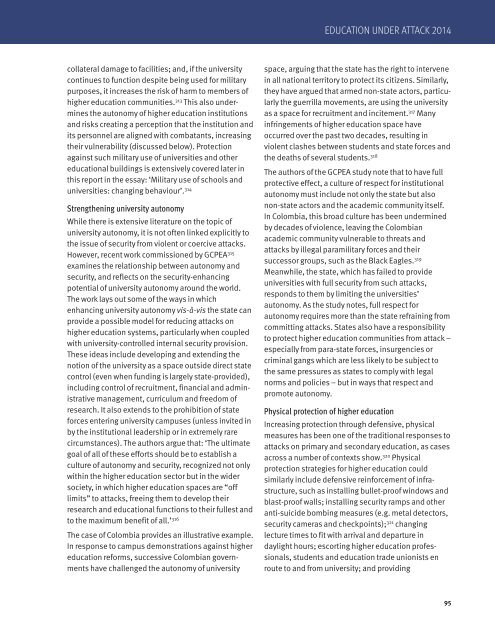eua_2014_full.pdf?utm_content=buffer4a392&utm_medium=social&utm_source=twitter
eua_2014_full.pdf?utm_content=buffer4a392&utm_medium=social&utm_source=twitter
eua_2014_full.pdf?utm_content=buffer4a392&utm_medium=social&utm_source=twitter
- No tags were found...
Create successful ePaper yourself
Turn your PDF publications into a flip-book with our unique Google optimized e-Paper software.
EDUCATION UNDER ATTACK <strong>2014</strong>collateral damage to facilities; and, if the universitycontinues to function despite being used for militarypurposes, it increases the risk of harm to members ofhigher education communities. 313 This also underminesthe autonomy of higher education institutionsand risks creating a perception that the institution andits personnel are aligned with combatants, increasingtheir vulnerability (discussed below). Protectionagainst such military use of universities and othereducational buildings is extensively covered later inthis report in the essay: ‘Military use of schools anduniversities: changing behaviour’. 314Strengthening university autonomyWhile there is extensive literature on the topic ofuniversity autonomy, it is not often linked explicitly tothe issue of security from violent or coercive attacks.However, recent work commissioned by GCPEA 315examines the relationship between autonomy andsecurity, and reflects on the security-enhancingpotential of university autonomy around the world.The work lays out some of the ways in whichenhancing university autonomy vis-à-vis the state canprovide a possible model for reducing attacks onhigher education systems, particularly when coupledwith university-controlled internal security provision.These ideas include developing and extending thenotion of the university as a space outside direct statecontrol (even when funding is largely state-provided),including control of recruitment, financial and administrativemanagement, curriculum and freedom ofresearch. It also extends to the prohibition of stateforces entering university campuses (unless invited inby the institutional leadership or in extremely rarecircumstances). The authors argue that: ‘The ultimategoal of all of these efforts should be to establish aculture of autonomy and security, recognized not onlywithin the higher education sector but in the widersociety, in which higher education spaces are “offlimits” to attacks, freeing them to develop theirresearch and educational functions to their <strong>full</strong>est andto the maximum benefit of all.’ 316The case of Colombia provides an illustrative example.In response to campus demonstrations against highereducation reforms, successive Colombian governmentshave challenged the autonomy of universityspace, arguing that the state has the right to intervenein all national territory to protect its citizens. Similarly,they have argued that armed non-state actors, particularlythe guerrilla movements, are using the universityas a space for recruitment and incitement. 317 Manyinfringements of higher education space haveoccurred over the past two decades, resulting inviolent clashes between students and state forces andthe deaths of several students. 318The authors of the GCPEA study note that to have <strong>full</strong>protective effect, a culture of respect for institutionalautonomy must include not only the state but alsonon-state actors and the academic community itself.In Colombia, this broad culture has been underminedby decades of violence, leaving the Colombianacademic community vulnerable to threats andattacks by illegal paramilitary forces and theirsuccessor groups, such as the Black Eagles. 319Meanwhile, the state, which has failed to provideuniversities with <strong>full</strong> security from such attacks,responds to them by limiting the universities’autonomy. As the study notes, <strong>full</strong> respect forautonomy requires more than the state refraining fromcommitting attacks. States also have a responsibilityto protect higher education communities from attack –especially from para-state forces, insurgencies orcriminal gangs which are less likely to be subject tothe same pressures as states to comply with legalnorms and policies – but in ways that respect andpromote autonomy.Physical protection of higher educationIncreasing protection through defensive, physicalmeasures has been one of the traditional responses toattacks on primary and secondary education, as casesacross a number of contexts show. 320 Physicalprotection strategies for higher education couldsimilarly include defensive reinforcement of infrastructure,such as installing bullet-proof windows andblast-proof walls; installing security ramps and otheranti-suicide bombing measures (e.g. metal detectors,security cameras and checkpoints); 321 changinglecture times to fit with arrival and departure indaylight hours; escorting higher education professionals,students and education trade unionists enroute to and from university; and providing95


